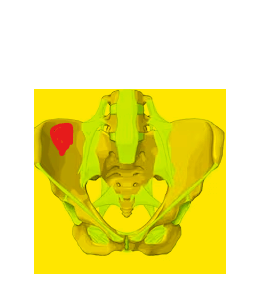Quick Overview
Iliac fossa is a large, smooth, concave surface on the internal surface of the ilium bone. It is part of the pelvic girdle and is located on the lateral (outer) surface of the pelvis.
The iliac fossa is important because it houses the iliacus muscles, which helps to flex the hip and rotate the thigh. The iliac fossa also contains a number of other important structures, including the obturator nerve, the iliac artery and vein, and the lateral cutaneous nerve of the thigh.

Table of Contents
Anatomy of the Iliac Fossa
It is a shallow, concave depression located on the inner surface of the ilium, which is the largest of the three bones that make up the hip. It forms the superior part of the hip bone and plays a significant role in articulating with the sacrum to create the sacroiliac joint.
Read also Subtalar Fossa and Hypophyseal Fossa
Location
It is situated within the pelvic region, positioned on the lateral aspect of the pelvis, flanking the sacrum. This anatomical location is strategically placed to support the spine and upper body while facilitating various movements of the lower limbs.
Boundaries
It is formed by the following structures;
Superiorly: Iliac crest
Inferiorly: Arcuate line
Anteriorly: Anterior border of the ilium
Posteriorly: Posterior border of the ilium
Structures
The structures found in this region are;
- Iliacus muscle
- Obturator nerve
- Iliac artery and vein
- Lateral cutaneous nerve of the thigh
Functions
- Housing the iliacus muscle: The iliacus muscle is a powerful muscle that helps to flex the hip and rotate the thigh.
- Providing attachment for other muscles: Provides attachment for a number of other muscles, including the psoas major muscle, the quadratus lumborum muscle, and the tensor fasciae latae muscle.
- Protecting internal organs: It helps to protect the internal organs, such as the small intestine, the colon, and the ureters.
Clinical Significance
It is susceptible to a number of injuries and conditions, including:
- Fracture: It can be caused by a direct blow to the pelvis or by a twisting force.
- Abscess: abscess is a collection of pus in the iliac fossa. It can be caused by an infection in the iliacus muscle or in another nearby structure.
- Tumor: It can be benign (noncancerous) or malignant (cancerous).
Associated Conditions
Conditions associated this fossa are;
- Fracture
- Abscess
- Tumor
- Appendicitis
- Diverticulitis
- Salpingitis
Treatment and Prevention
The treatment for iliac fossa injuries and conditions depends on the severity of the injury or condition. Some common treatment options are;
- Rest
- Ice
- Compression
- Elevation
- Medications
- Surgery
The following tips can help to prevent iliac fossa injuries and conditions:
- Wear protective gear when participating in sports or other activities that could put you at risk of injury.
- Avoid lifting heavy objects.
- Maintain a healthy weight.
- Exercise regularly to strengthen the muscles around your pelvis and hips.
Questions
Q-1 What is the Iliac Fossa, and where is it located?
It is a concave depression within the ilium, which is one of the three bones that make up the hip bone. It is situated on the lateral aspect of the pelvis, flanking the sacrum.
Q-2 What is the function of the Iliac Fossa in the body?
The Iliac Fossa serves as a critical component of the pelvic girdle, providing support for the upper body and facilitating lower limb movements. It also acts as an attachment site for muscles and ligaments involved in hip joint stability.
3- What conditions are associated with the Iliac Fossa, and what are their symptoms?
Conditions related to the Iliac Fossa may include hip joint disorders like osteoarthritis or sacroiliac joint dysfunction, as well as muscle or ligament injuries. Symptoms can range from pain and limited mobility to functional impairments.
4- How are Iliac Fossa-related conditions diagnosed and treated?
Diagnosis typically involves physical examination, imaging studies, and sometimes specialized tests like diagnostic injections. Treatment options vary but may include physical therapy, medications, pain management strategies, and in some cases, surgery.
Q-5 Are there preventive measures to maintain the health of the Iliac Fossa?
Preventing Iliac Fossa-related issues often involves maintaining proper posture, engaging in regular exercise to strengthen supporting muscles, and avoiding activities that place excessive strain on the hip joint. Early diagnosis and prompt treatment of any underlying conditions can also contribute to prevention.
